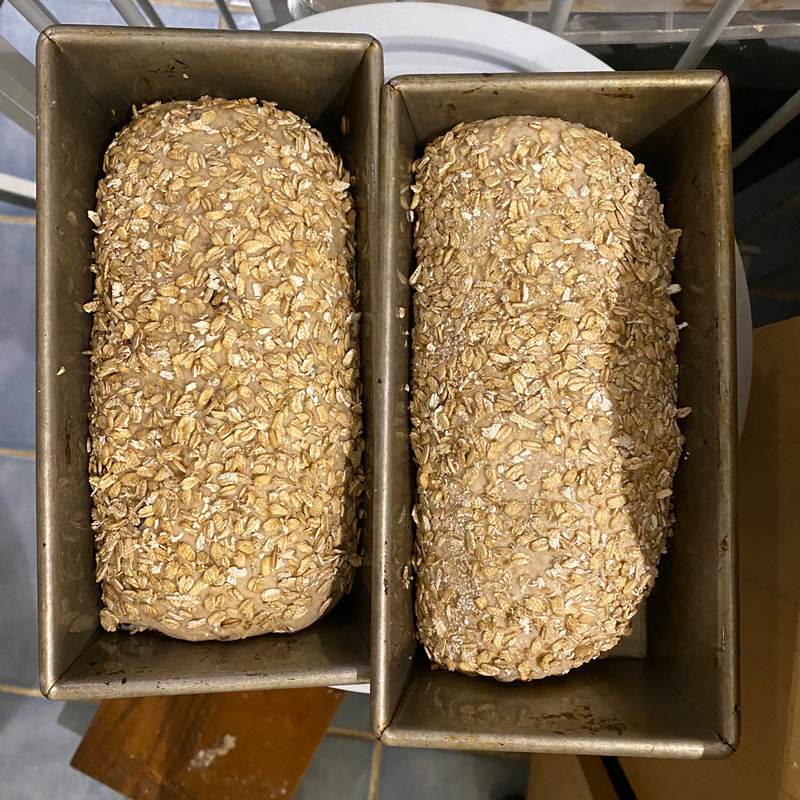|
HONEY OAT WHEAT SOURDOUGH SANDWICH BREAD RECIPE Squishy sandwich bread is a bagged lunch necessity, but that doesn’t mean it has to be gummy and flavorless like the Bunny bread of so many of our childhoods. This honey oat wheat sourdough sandwich bread is a wholesome, lightly sweetened, and naturally leavened alternative, perfect for PB&Js and breakfast toast. TIME FRAME* Active time: 1:20 | Inactive time: 13:30 - 39:15 | Total time: 14:50 - 40:35 *This rough time frame assumes that you have an active sourdough starter at 100% hydration to use to start your levain. If your starter has been in the fridge for a week, add at least a day to the recipe timing below to allow for 2-3 feedings (spaced 8 hours apart) before mixing your levain. If it has been in your fridge for longer than a week, add at least two days to the recipe timing to give it enough feedings and time to return to full strength. Additionally, the schedule is based on a room temperature of 68 - 72 degrees F. If you find your house and ingredients running cooler or warmer than that, you may need to slow down or speed up the timings accordingly. RECIPE YIELD: 2 x 1kg loaves LEVAIN BUILD 33g starter 132g water 132g bread flour (I use King Arthur Baking’s Sir Lancelot flour, which is similar to their retail, blue-bagged bread flour) OAT PORRIDGE 185g rolled or stone ground oats (I prefer Purple Mountain Grown’s rolled oats or home-ground oat groats or Castle Valley Mill’s stoneground oats) 225g boiling water FINAL DOUGH 350g water 275g levain 90g honey 410g oat porridge 18g non-iodized kosher salt or sea salt 460g hard whole wheat flour (Migrash Farm’s No. 18 Bolles or Maverick flour is my go-to) 325g bread flour
INSTRUCTIONS MAKING THE PRE-FERMENT & PORRIDGE Active mix time: 0:15 | Inactive fermenting time: 6 - 8 hours | Total time: 6:15 - 8:15 1. About 6 - 8 hours before you plan to mix your final dough, build your levain and make your oat porridge. Put water on to boil and get your mise-en-place by assembling your scale, sourdough starter, bread flour, rolled or stone ground oats, a pitcher of room temperature water, a spatula or spoon, a medium-sized mixing bowl and a heat-resistant container. 2. Start with your levain by weighing out and mixing together 33g of your active sourdough starter with 132g water and 132g bread flour in the large bowl. Scrape down the sides, cover, and leave to ferment. 3. Then make the oat porridge by weighing out 185g rolled or stone ground oats in the heat-resistant container. When the water has come to a boil, carefully pour in 225g and mix together as the oats begin to thicken and congeal. Let cool to room temperature before covering. 4. Once your levain has more than doubled in size and appears to be on the cusp of slowing down its expansion, it’s ready to use. MIXING & FERMENTING THE FINAL DOUGH Active mix & fold time: 0:40 | Inactive fermenting time: 4 hours | Total time: 4:40 1. Get your baking space organized by gathering your scale, levain, oat porridge, bread flour, whole wheat flour, a pitcher of room temperature water, honey, and salt. 2. Using the large bowl with the levain already inside, combine the rest of the ingredients all at once, starting with liquids and then working through the dry ingredients: 350g water, 90g honey, 410g oat porridge, 18g salt, 460g whole wheat flour, and 325g bread flour. Mix and knead the dough with your hands until the oat porridge is thoroughly broken up and the components are hydrated and combined. If it feels like there are dry spots after working the dough for a few minutes, add 25g of water at a time, mixing and kneading between additions, until the dough feels wet but not too sticky. Be careful with adding more water, as the porridge is deceptively wet and it's easy to overdo it. 3. Scrape down the sides of the bowl, then cover the dough and leave it to rest for 1 hour.
SHAPING & PROOFING Active shaping time: 0:20 | Inactive proofing & retarding time: 1:30 - 25:30 | Total time: 1:50 - 25:50 1. Prep your baking space by assembling two shallow containers or plates, one with a wet towel on it and the other with a mound of rolled or stone ground oats, and spraying your loaf tins with nonstick spray or dusting your bannetons/proofing bowls with flour. Ensure you have a clean, lightly floured surface on which to divide and shape your dough. 2. Turn your dough out onto your workspace surface and divide it in half, either by precise weight (1kg each) or the more helter-skelter eyeball method.
BAKING Active loading & scoring time: 0:05 | Inactive heating & baking time: 1:30 - 1:45 | Total time: 1:35 - 1:55 If baking in loaf tins: 1. Set the oven to 400 F. If using a steam-making agent, add your receptacle (like an old cast-iron or other oven-safe pan) to the oven to preheat and put water on to boil to add to it later. If using a spray bottle/mister, fill it with warm water in preparation.
4. Remove the loaves and shut off the oven. If you want a soft crust, brush the tops with oil or melted butter and then allow the loaves to cool for 5 minutes before carefully removing them from the tins. 5. Wait 2 hours before slicing and consuming. Store in an airtight container or plastic bag to keep soft. If baking freeform batards in a dutch oven: 1. Set the oven to 450 F and add your dutch oven(s) to pre-heat. If you only have one dutch oven, move one loaf to the fridge at this time to prevent it from overproofing while you wait to bake them one after the other.
5. Wait 2 hours before slicing and consuming. Store in an airtight container or plastic bag to keep soft.
0 Comments
Leave a Reply. |
ArchivesCategories |








 RSS Feed
RSS Feed